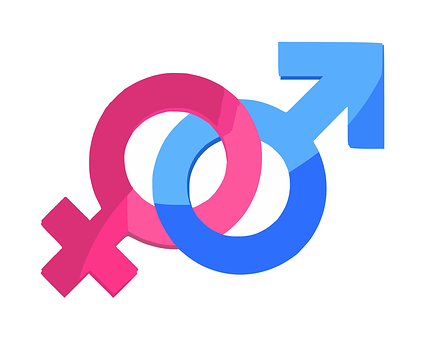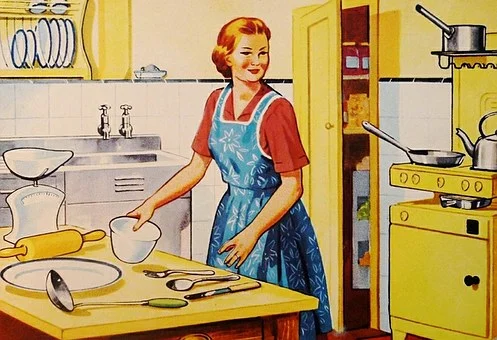1.3 Sociology of Gender
A sub-study area of sociology is the sociology of gender, which looks at how the world and society interact within the lens of gender—including sexuality, gender expression, gender identity, and so forth. Gender is the attitudes, behaviors, norms, and roles that a society or culture associates with an individual’s sex assigned at birth, thus the socially constructed differences between female and male; the meanings that are attached to being feminine or masculine.


Figure 1.8 the gender binary assumes male or female, and we can see this in many pieces of society including restrooms which were also mentioned in the introduction to this chapter.
The gender binary (the notion that someone is either male or female as in figure 1.8) is specific to certain cultures and is not universal. Some cultures view gender as fluid. Anthropologists found that among some Indigenous tribes the terms berdache or “two-spirit” refer to individuals who occasionally or permanently dressed and lived as a different gender. Berdaches also participated in labor roles traditionally associated with their preferred masculine or feminine style of clothing. Samoan culture accepts a “third gender,” fa’afafine, which translates as “the way of the woman.” It is a term used to describe individuals born biologically male but who embody both masculine and feminine traits. Fa’afafines are considered an important part of Samoan culture. Individuals from other cultures may mislabel their sexuality because fa’afafines have a varied sexual life that may include men and women (Poasa 1992). We’ll explore nonbinary identities throughout the world in Chapter 4.
Gender is a constant part of who and what we are, how others treat us, and our general standing in society. Gender differences are visible in different aspects of behavior, emotions, relationships, and the organization of social institutions such as work and family. Often gender is divided into two major categories: women and men. The social construction of gender helps us understand the expectations of women’s and men’s characteristics and behavior. By understanding how gender is socially constructed, sociologists can study how gender inequality occurs.
1.3.1 Patriarchy and Gender
Our society was founded upon and currently functions on the ideas of patriarchy, meaning men hold power. A patriarchal society is one where characteristics associated with men and masculinity hold more power and authority than those associated with women. Within a patriarchal society, women hold a lower status than men. Even valued characteristics of women, such as empathy, nurturance, and care for others, are ranked lower. Because men and boys are held in higher social regard than women and girls and are granted more advantages and rights, gender differences produce gender inequality. We also see that patriarchy is why gender and sexuality are so closely linked, where one’s gender identity should correlate to their sexual attraction to the opposite gender. It implies that women should be attracted to men and men to women and that we should uphold the norms of homemaker/breadwinner.

Figure 1.9 Retro ‘homemaker’ advertisement, reinforcing ideals of what women should be in contrast to men.
Patriarchy also has historical racial implications that impact society today. Since slavery, Black men have been hypermasculinized and hypersexualized at the expense of their humanity. White men painted Black men as a “threat” to the purity/femininity of white women. In many ways, Black women are also hypermasculinized because racism painted them as the antithesis of womanhood. We see this today with tropes of “strong Black women” or the idea that Black women are able to withstand pain/feel less pain than white women (still widely believed in the U.S. healthcare system, as we will explore in Chapter 9). Asian American men have been historically de-masculinzed in the patriarchal structure and racistly painted as “smaller” and “weaker” men, while Asian American women are hyperfeminized and made out to be sexually submissive objects.
1.3.2 Early Sociology of Gender
Due to our patriarchal foundations in American society, the early sociology of gender primarily focused on women under the assumption that only women had a gender. Men were the only “people” spoken about in laws, stories, and plans for this country, while women were the “others.” Their gender only mattered because they were not men. This was the result of common and institutionalized inequalities that were believed to only affect women at the time, including but not limited to work, home, rights, and healthcare. Many women were strictly bound to housework and child-rearing and were considered the property of their husbands by default. They did not own property or their own money and could not vote or participate in politics.
The history of the sociology of gender is fairly short in relative terms, but it is one of the most significant subfields within the sociological field of study. For example, the term “gender role” was coined by John Money only back in 1955. He defined gender roles as “all those things that a person says or does to disclose himself or herself as having the status of boy or man, girl or woman” (Money, 1955). Many of the sociology of gender theories and research were developed during the 1960s and 1970s when feminist theory became prominent through the women’s rights movement. Some major historical moments for feminist theory included the publication of The Feminine Mystique by Betty Friedan in 1963 and research by Ann Oakley in 1969, who earned a PhD for research on women’s attitudes to housework.
Most sociology of gender courses and research were more under the description of the sociology of women. Through this period, the research was based on women and femininity and mostly ignored all other genders including men and masculinity up until the 1980s and 1990s. In the late 1980s, some foundational concepts and theories were brought to the field by Candace West and Don Zimmerman in their article “Doing Gender” (1987), by Judith Butler in “Performative Acts and Gender Constitution: An Essay in Phenomenology and Feminist Theory” (1988). Theorists and researchers such as R. W Connell and Michael Kimmell incorporated masculinity into the sociology of gender in the 1990s. The field then shifted to not just the sociology of women but the sociology of all genders. We’ll explore sociological theories of gender and how they critique the dominant culture in Chapter 5.
1.3.3 Impact of Gender Analysis
Gender analysis is simply looking at things through the lens of gender to understand relationships between humans, their activities, relations to government, employment, access to resources, and social problems. It takes an intersectional approach that looks at gender and its relationships to class, race, disability, ethnicity, culture, education, age, and other statuses to understand sociological patterns and their impact. Intersectionality was an approach advanced initially by women of color. It is a critical look at how identities and characteristics (such as ethnicity, race, gender, etc.) overlap and influence each other to create complex hierarchies of power and oppression.
Articulated by legal scholar Kimberlé Crenshaw (1991), the concept of intersectionality identifies a mode of analysis integral to women, gender, and sexuality studies. Within intersectional frameworks, race, class, gender, sexuality, age, ability, and other aspects of identity are experienced simultaneously, and the meanings of different aspects of identity are shaped by one another. In other words, notions of gender and the way others interpret a person’s gender are always impacted by notions of race. For example, a person is never received as just a woman, but how that person is racialized impacts how the person is received as a woman, imagine this as a venn diagram where one experiences multiple intersections in different ways, but they are not separable of each other (figure 1.10). We’ll explore intersectionality in greater depth in Chapter 5.

1.10 Think of intersectionality as a venn diagram with more circles, where they are never separate, but as a whole our intersections impact our experiences and how we are recieved by others.
How gender affects everyday interactions and the larger socio-economic and socio-political spheres can be seen when using a gender analysis. As with other sociological topics, we begin by asking questions. When it comes to dress codes in educational institutions, different genders (men, women, boys, girls, and LGBTQIA+ people) likely have different experiences. To understand these differences, we would first find out what the policies are, then ask how they affect different genders. The intention of the dress code may seem sincere and well-intentioned but may continue a practice of inequality and othering. This not only affects individuals but groups and larger institutions as well.
Engrained power dynamics are an excellent reason to look at experiences, policies, social structures, and social institutions through the lens of intersectionality. We can see the power dynamics of the patriarchy, but also that power dynamics are at play between women concerning attractiveness, marriage status, education, sexuality, and race. The same power dynamics exist between and within all groups. We can’t look just at these as hegemonic (dominant) groups of individuals. In gender analysis, we need to use an intersectional approach to look at access to resources and power.

